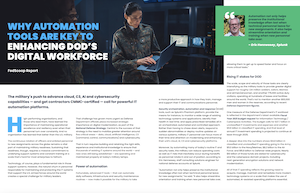- Sponsored
- Defense
How automation tools add resiliency to DOD’s IT workforce

The continuous rotation of officers and enlisted personnel is a vital part of maintaining military readiness. However, preserving institutional knowledge of thousands of existing IT systems — as well as new ones still being established — remains crucial to keeping Defense Department and military IT systems operating securely, says a new report.
That is why military leaders should be looking more proactively at automation technology, that performs repeatable tasks and reduces the risks and costs associated with staff turnover.

Read the final report.
“Automation not only helps preserve the institutional knowledge often lost when technical personnel leave for new assignments, it also helps streamline orientation and training when new personnel take over, allowing them to get up to speed faster and focus on more critical tasks,” said Eric Hennessey, staff consulting solutions engineer for national defense accounts at Splunk.
The report, produced by FedScoop and underwritten by Splunk, takes a closer look at how advanced security orchestration, automation and response (SOAR) tools offer a more productive approach for DOD organizations to support their IT and communications personnel.
SOAR tools, such as Splunk’s Phantom platform, “provide the means to monitor a wide range of existing technology systems and applications; identify their health in real time; and apply prescribed remedies all in an orchestrated, automated and controlled approach,” says the report.
The report details multiple benefits of automating IT tasks. One of the most significant benefits, according to the report, is in reducing the risk of errors that often occur performing repetitive tasks. Another is the ability to codify workflows, to reduce training requirements. Automation also helps security teams detect, investigate and respond to threats at machine speed.
Hennessey points to one example of how personnel are constantly rotating in and out of assignments, and the need for user accounts to be constantly created and removed. “Those types of processes are pretty straightforward and repeatable and very easy to automate. By taking that workload off the service desk staff, they can concentrate on other more important things,” he said.
From the military’s perspective, IT workforce automation is both fundamental and essential to meet the scale and scope of their needs as they push towards digital modernization and data-driven readiness.
According to Anthony Perez, Splunk’s global solutions architect, automating IT processes is also about to take on much greater importance for defense contractors as well.
In order to meet certification requirements for the Pentagon’s Cybersecurity Maturity Model Certification (CMMC), “DOD contractors will need to deploy and adopt proven enterprise-grade technology that can be iteratively tailored and extended,” explained the report.
“From the contractor perspective, I envision organizations leveraging [Splunk’s automation tools] to automate the self-evaluation of their cyber security maturity, identification of gaps, and generation of the bulk of their technical evidentiary package for C3PAO [third-party] auditors to use in their evaluation and CMMC-audit and accreditation process,” says Perez.
These experts expect the need for powerful IT automation platforms to continue to grow as DOD officials place increased strategic importance on digital modernization as part of the National Defense Strategy. That means greater focus on data, cloud, artificial intelligence, C3 and cybersecurity — as well as the right skills and experience to ensure these programs flourish.
Find out more on how automation and orchestration tools can accelerate the performance of the IT workforce.
This article was produced by FedScoop and sponsored by Splunk.






